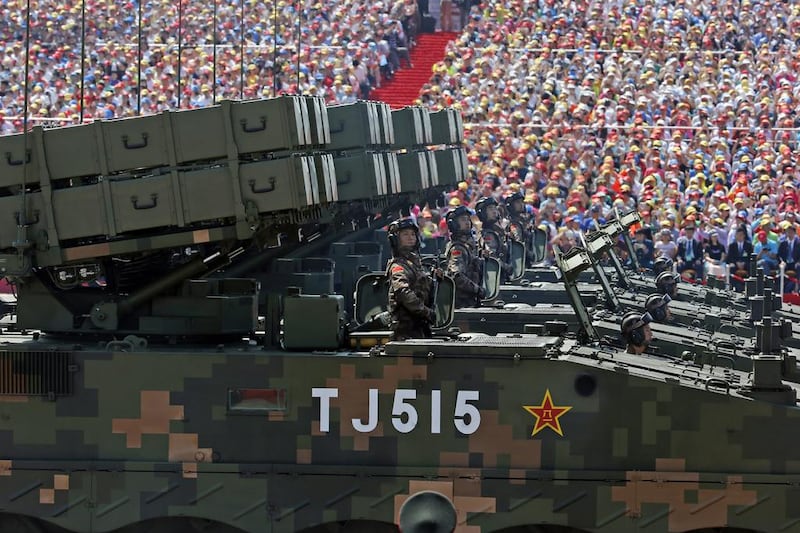As China celebrated the 70th anniversary last Thursday of its victory in the “Chinese People’s War of Resistance Against Japanese Aggression” – or the end of the Second World War – many around the globe watched with some trepidation as the military parade marched through Beijing.
True, president Xi Jinping did promise to reduce the country’s armed forces by 300,000. But, given that significant numbers of these are expected to be reshuffled into other branches of the state security apparatus, and that it will still leave the People’s Liberation Army two million strong, the display of might remained potent and significant. China normally only holds such parades once a decade, to commemorate the founding of the people’s republic.
If concern was expressed about the temptations of militarism by commentators in Washington and London, the disquiet was of a different order in Asia, where the effect of a more assertive China could be both economic and territorial. And no one should underestimate just how worried some countries are about their powerful neighbour’s ambitions.
In June, Benigno Aquino, the Philippines’ president, compared China’s land reclamation in disputed areas of the South China Sea to German expansionism in the 1930s.
“If somebody said stop to Hitler at that point in time, could we have avoided World War Two?” he asked. His remarks were condemned as “outrageous and unreasonable” by China’s foreign ministry, but he is not alone.
I have seen Vietnamese officials in a state of near despair over China’s insistence on their ownership of the “islands in the South China Sea and the adjacent waters” that comes very close to the coasts of several states in the region. Vietnam, the Philippines, Brunei and Malaysia all contest the claim, while South Korea and Japan both have disagreements with China over the East China Sea.
Recent emphasis on China’s “core national interests” has suggested that the term has expanded its remit. Once assumed to refer to Taiwan, which has never united with the People’s Republic, and the autonomous regions of Xinjiang and Tibet, it now appears to cover the South and East China seas too. By definition, core interests are not to be abandoned lightly. That, and a distinctly ambiguous attitude towards international law – or claims that international law is itself ambiguous – fuel fears that China’s rise may not be as peaceful or as beneficial to all as its officials never tire of saying.
“We have heard much about ‘win-win cooperation’,” said a sceptical Japanese former official at the annual Asia Pacific Roundtable in Kuala Lumpur this June. “Some of us think that means China wins twice.”
Ultimately these fears are made worse by doubts about US resolve should China ignore complaints from its smaller neighbours and act on its own – especially in the South China Sea – backed, if necessary, by an increased seagoing military presence. The question: “Where are America’s red lines?” has long hovered unanswered.
One possible response emerged last month in a new US defence department paper, Asia-Pacific Maritime Security Strategy.
This acknowledges the importance of the region, with eight out of the world’s 10 busiest container ports, and with nearly 30 per cent of global seaborne trade passing through the South China Sea. But it also admits the scale of the “facts on the ground” that have been created.
“China has now reclaimed 17 times more land in 20 months than the other claimants combined over the past 40 years,” it states. “The infrastructure China appears to be building would enable it to establish a more robust power projection presence. China is unilaterally altering the physical status quo in the region, thereby complicating diplomatic initiatives that could lower tensions.”
As a liberal with an optimistic view of human nature, I’m inclined to give the benefit of the doubt to the Chinese officials who I’ve heard talk about the “amity, sincerity and inclusiveness” with which they want to characterise relations in the region. “A good neighbour is a valuable treasure,” said another.
That may have been a cosy gloss, but any suggestions that China may wish to return to the Imperial Tributary System of foreign relations appear very far-fetched.
Unintended incidents are certainly possible with both the US and China increasing their armed forces in the region. Despite the predictions of hawkish doomsayers, however, the prospect of armed conflict between the two powers seems unlikely – not least as it is most certainly not in the interests of two countries that now have a trading relationship worth over $550 billion per year.
But this is just as much because, as the US defence department paper puts it: “China is using a steady progression of small, incremental steps to increase its effective control over disputed areas and avoid escalation to military conflict.”
Having read the paper in full, there is nothing in it that suggests the US could definitively put a stop to this “salami-slicing” approach. In the South China Sea, at least, there are no red lines.
China takes the very long view, and patiently maintains its claims on areas of “core interest” such as Taiwan and Arunachal Pradesh (which it says was illegally annexed by India during the British Raj) for decades while nothing very much changes. If it can, why shouldn’t it continue to take slivers off the salami of the South China Sea? If you keep at it for long enough, after all, you end up with most of the sausage. That may be the reality that the region has to come to accept. It is, at least, a far more positive fate than the “shaking of the world” Napoleon warned of when the “sleeping giant” of China awoke.
Sholto Byrnes is a senior fellow at the Institute of Strategic and International Studies, Malaysia





